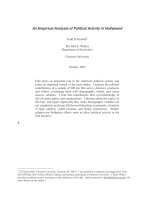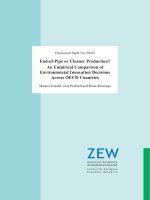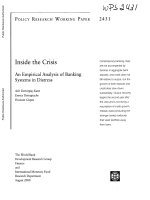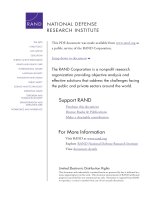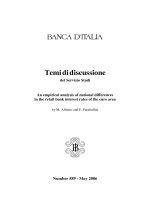the determinants of the global broadband deployment - an empirical analysis - sangwonlee_fullpaper
Bạn đang xem bản rút gọn của tài liệu. Xem và tải ngay bản đầy đủ của tài liệu tại đây (449.79 KB, 17 trang )
The Determinants of the Global Broadband Deployment: An Empirical Analysis
Submitted for presentation to the Pacific Telecommunications Council’s 08 Conference
June 2007
Sangwon Lee
Ph.D. Student and Alumni Graduate Fellow
Department of Telecommunication
College of Journalism and Communications
University of Florida
Gainesville, FL 32611
United States
Tel. 1-352-281-4951
The Determinants of the Global Broadband Deployment: An Empirical Analysis
Abstract
The world of telecommunications has changed rapidly as we enter the era of convergence
between broadband Internet, wireless networks, and the content sector. The provision of
advanced video services via the broadband platform will be impossible without the successful
diffusion of broadband services. The current deployment of such services is significantly more
advanced in some countries than others. Through two different econometric analyses, this study
examines the factors affecting such differences.
Based on the Gruber and Verboven (2001)’s model, this study estimates a logistic model of
broadband penetration. This logistic regression model employs 240 observations for broadband
services from OECD (Organization for Economic Co-operation and Development) countries.
The logistic regression model covers all 30 OECD countries from 1999 to 2006. This study also
estimates a linear regression model of broadband penetration. The linear regression model
employs approximately 220 observations for broadband services from ITU (International
Telecommunication Union) membership countries. The linear regression model covers 56
countries from 2003 to 2006. The results of this empirical study might show that platform
competition, Local Loop Unbundling Policy (LLU), broadband speed, information and
communication technology (ICT) infrastructure, Internet use, population density, international
Internet bandwidth, content, and Institutional environment contribute to the global broadband
adoption. The impacts of platform competition might be strong when market share of dominant
technology and non-dominant technology is similar. This study also may find that mobile
broadband is neither a complement nor a substitute for fixed broadband yet. Main findings of this
study suggest policy and strategy implications.
1
Introduction
The world of telecommunications has changed rapidly as we enter the era of convergence
between broadband Internet, wireless networks, and the content sector. Broadband infrastructure is a
key component of the knowledge economy. Communication technologies that provide high-speed,
always-on connections to the Internet for large numbers of residential and small-business subscribers
are commonly referred to as “broadband” (Crandall, 2005). Widespread and affordable broadband
access encourages innovation, contributes to productivity and growth in an economy, and attracts
foreign investment (ITU, 2003a). The provision of advanced IP-based services such as IP telephony
and IP video will be impossible without the successful diffusion of broadband.
In spite of the overall rapid growth in broadband diffusion, many countries are still in the early
stages of broadband deployment and are assessing policy strategies to promote faster adoption. The
provision of advanced video services via the broadband platform will be impossible without the
successful diffusion of broadband services. The current deployment of broadband Internet is
significantly more advanced in some countries than others. According to the latest Organization for
Economic Co-operation and Development (OECD) penetration data (December 2006), Denmark,
Netherlands, Iceland, Korea, and Switzerland are leading broadband economies among OECD
countries (see Table 1, pg. 3).
On the supply side, many countries have considered local loop unbundling regulation and
facilities-based competition as important policy initiatives to promote rapid broadband diffusion.
Local loop unbundling (LLU) — which refers to the process by which incumbent carriers lease,
wholly or in part, the local segment of their telecommunications network to competitors — has been
considered an important policy to stimulate intra-modal competition (OECD, 2003). It is also widely
held that platform, inter-modal competition (facilities-based competition among several different
broadband platforms) is crucial for reducing prices, improving quality of service, increasing
2
customers and promoting investment and innovation (DotEcon & Criterion Economics, 2003). In
spite of a growing body of literature about broadband adoption, only a few cross-cultural empirical
studies about the important factors of global broadband adoption exist.
Through two different econometric analyses, this study examines the factors affecting global
broadband deployment. Using non-linear and linear regression, this study assesses whether or not
platform competition, LLU policy, broadband speed, Information and Communication Technology
(ICT) infrastructure, Internet use, income, education, population density, fixed broadband price,
content, international Internet bandwidth, mobile broadband price, teledensity, and institutional
environment are drivers of global fixed broadband deployment. Based upon the results of this
empirical research, this paper suggests policy and strategy implications to policy-makers and
broadband service providers.
Literature Review
Broadband adoption has been steadily growing throughout the world. According to the
International Telecommunication (ITU), there were about 215.5 million total broadband subscribers
and 3.3 subscribers per 100 inhabitants in the world in 2005 (ITU, 2006). Broadband adoption rates
over the first 10 years is faster than other offerings like cellular and dial-up services across OECD
countries (OECD, 2006). Internationally, the dominant broadband access platforms are DSL (64.34
%) and cable modem (29.89 %), though other platforms, such as fiber-to-the-home and wireless
broadband access serve around 6 % (ITU, 2006).
As of December 2006, Denmark, the Netherlands, Iceland, Korea, and Switzerland were the top five
OECD countries in terms of broadband penetration rates (OECD, 2007; Table 1). Despite the recent
growth of broadband access and the largest raw number of broadband subscribers, with a 19.6
percent national broadband penetration rate per 100 inhabitants, the United States ranks only 15th
among 30 OECD countries (OECD, 2007).
3
Table1. Fixed Broadband Penetration (Top OECD countries) by Technology, December 2006
Note. Data were derived from Organization for Economic Co-operation and Development (2007).
Source: OECD broadband statistics. Paris: OECD.
In terms of overall global broadband market share by subscribers, the United States leads the
group, garnering about 22.9 percent of the global broadband subscribers. Nevertheless, the region of
Asia trumped all others in broadband adoption with 38.47 percent of the world broadband market
share (ITU, 2006). Evidently significant regional differences exist in the number of broadband
subscribers.
There is a growing body of empirical research about fixed broadband deployment. Some
empirical studies find that inter-modal competition, local loop unbundling (LLU), demographic
variables in the supply-side and demand side variables such as income and broadband price increase
the fixed broadband adoption. Through an empirical analysis of 30 OECD countries, Cava-Ferreruela
and Alabau-Muňoz (2006) suggest technological competition, low cost of deploying infrastructures,
and prediction to use new technologies might be key factors for broadband supply and demand,
respectively. In addition, using statistical analysis of data from 14 European countries, Distaso and
others (2006) argue that inter-platform competition drives broadband adoption, but that competition
in the DSL market does not play a significant role. Using logit regression analysis Garcia-Murillo
(2005) finds that unbundling an incumbent’s infrastructure only results in a substantial improvement
in broadband deployment for middle-income countries, but not for their high- income counterparts.
Kim and others (2003) suggest the preparedness of a nation and the cost conditions of
deploying advanced networks are the most consistent factors explaining broadband uptake in OECD
DSL
Cable
Fibre/LAN
Total
Rank
Total
Subscribers
Denmark
19.6
9.4
2.8
31.9
1
1,590,539
Netherlands
19.5
12.0
0.4
31.8
2
5,192,200
Iceland
28.8
0
0.2
29.7
3
87,738
Korea
11.4
10.7
7.0
29.1
4
14,042,728
Switzerland
18.8
8.8
0
28.5
5
2,140,309
4
countries. Using generalized least squares multiple regression analysis, Grosso (2006) also finds that
competition, income, and unbundling have a positive impact on broadband diffusion (see Table 2).
Table2. International empirical studies examining broadband adoption factors
Study
Indepentdent variables
Countries
Number of
Observations
Significant Findings
Kim et. al. (2003)
Broadband price
OECD 30
countries
30
Preparedness of a nation
Dial-up service price
Population density
Income
Preparedness of a nation
Competition
Population density
Policy (unbundling, cross ownership,
government funding)
Garcia-Murillo (2005)
Broadband price
ITU
approximately
Observations varies
Broadband price
Income
100 countries
depending on the model
Income
Education
(18-92)
Population density
Competition
Competition
Population density
Internet access
Policy (unbundling, cross ownership)
Unbundling
Content
Personal computers
Internet access
Distaso et. al. (2006)
Intra-modal competition
EU 14 countries
158 (15 time periods)
Inter-modal competition
Inter-modal competition
LLU price
Rights of way
LLU price
Price of leased line
Price of ten minutes call
Cava-Ferreruela and
Broadband price
OECD 30
countries
90 (3 years: 2000-2002)
Technological competition
Alabau-Muňoz (2006)
Competition
Cost of deploying
infrastructures
Infrastructure investment
Economic indicators
Telecom services penetration
Demographic indicators
Internet indicators
Economic indicators
Demographic indicators
Education indicators
Social indicators
Grosso (2006)
Competition
OECD 30
countries
117 (4 years: 2001-2004)
Competition
Income
Income
Unbundling
Unbundling
Fixed Internet penetration
5
Despite existing research efforts to better understand broadband adoption, the influence of
important variables on global broadband adoption across countries — such as platform competition,
LLU, population density, ICT infrastructure, fixed broadband price, Internet use, content, and
broadband speed — have not been clearly understood in a single systematic study (see Table 2).
There is no empirical study whether institutional environment and international Internet bandwidth
influenced the global broadband deployment.
Also, no published empirical study examines whether mobile broadband is a complement to
or a substitute for fixed broadband. Based upon research that suggest cell phones serve as a substitute
for wired-line phone service (e.g., ITU, 2003c), one might expect a similar relationship between
broadband wireless services and fixed broadband.
Table 2 illustrates the variables and findings of empirical, international broadband
deployment studies. Accordingly, based on the literature reviewed, this study proposes the following
research questions (RQs):
RQ1: Does platform competition and LLU policy influence global broadband deployment?
RQ2: Do other factors such as income, population density, fixed broadband price, broadband speed,
Information Communication Technology (ICT) infrastructure, education, international Internet
bandwidth, Internet use, content, teledensity, and institutional environment significantly
influence global broadband adoption?
RQ3: Is mobile broadband a complement to or a substitute for fixed broadband?
The Model, Method and Data
To examine determinants of the global broadband deployment, this study employs both non-
linear and linear regression analysis. This logistic regression model (non-linear regression model)
employs 240 observations for broadband services from OECD (Organization for Economic Co-
operation and Development) countries. This study also estimates a linear regression model of
broadband penetration. The linear regression model employs approximately 220 observations for
6
broadband services from ITU (International Telecommunication Union) membership countries.
1. Non-linear Model of Broadband Diffusion
The diffusion of new technologies is usually nonlinear. This study follow Gruber and
Verboven (2001) and estimate a logistic model of broadband penetration. In many countries fixed
broadband penetration is nonlinear, and that it resembles the standard S-shaped pattern of the logistic
curve. Letting
it
y
denote the percentage of country i’s population that has broadband access to the
Internet by time t, the standard logistic diffusion equation is:
)exp(1
*
tba
y
y
itit
it
it
!!+
=
, (1)
where
it
a
and
it
b
are parameters, as discussed below, and
*
it
y
is the penetration ceiling or percentage
of potential adopters.
The parameter
it
a
in equation (1) is a constant of integration that gives the initial value of
broadband penetration.
1
A positive value shifts the S shaped function upwards while a negative one
shifts it downwards, without modifying the S-shape. Not all individuals in a country adopt a new
technology, such as broadband, regardless of how inexpensive broadband may become. This is
captured in the model by the ceiling parameter
*
it
y
. Finally, the parameter
it
b
in equation (1) captures
the speed of adoption. This can be seen by differentiating equation (1) with respect to time.
The parameters in equation (1) can vary with characteristics such as income, prices, population
density, and other country characteristics. Two broad classes of logistic diffusion models have been
proposed: the variable-ceiling logistic and the variable-speed logistic. Letting the ceiling vary with
country characteristics poses significant estimation problems. There is no guarantee that the
1
Note that
0
1
*
!
+
!
"
tas
e
y
y
it
a
it
it
.
7
parameter will stay at theoretically justifiable levels, or that the model will converge. The variable-
speed logistic model is easier to estimate and the speed of adoption can be positive or negative,
depending on the movement of exogenous factors. Therefore this study allows the speed of diffusion
to vary with policy variables
j
it
D
and country socio-economic characteristics
it
X
as follows:
!!!
it
J
j
j
it
j
it
XDb ++=
"
=1
0
. (2)
The parameter
0
!
represents the natural speed of adoption. The country characteristics included
in
it
X
are supply and demand shifters suggested by previous empirical research on the determinants
of fixed broadband adoption. They are: real GDP per capita expressed in constant 2000 US Dollars as
a measure of income, the number of computers per 100 inhabitants as a measure of ICT
infrastructure, population density as determinants of deployment cost, Internet usage, and the number
of Internet hosts per 100 inhabitants as a proxy for Internet content.
The policy variables included in our study are dummy variables capturing the unbundling of
the local loop and the existence of platform competition. Our measure of platform competition equals
one for years in which both cable and DSL subscriber existed in the country. The local loop
unbundling dummy equals one for years when unbundling was in effect and zero otherwise. The
dummy variables thus change over time, depending on the timing of the introduction of competition
and the year when unbundling began. Some of the previous studies have found that inter-modal
competition and local loop unbundling are important determinants of broadband penetration (Cava-
Ferreruela & Alabau-Muňoz, 2006). Table3 shows the variables, their measures, and the data
sources.
Table 3 about here
8
2. Linear Model of Broadband Diffusion
To capture more diverse determinants of global broadband deployment, a multiple regression
analysis (linear model) is implemented. To examine the influences of quantifiable variables on the
diffusion patterns of fixed broadband, this paper formulated the following multiple regression model.
Y
t
(BPR) = β
0
+ β
1
(Platform Competition) + β
2
(Fixed Broadband Price) + β
3
(Speed) +
β
4
(Income) + β
5
(ICT Infrastructure) + β
6
(Education) + β
7
(Population Density) +
β
8
(Price of Mobile Broadband) + β
9
(Content) + β
10
(Internet Usage) +
β
11
(Teledensity) + β
12
(International Internet Bandwidth) +
β
13
(Institutional Environment) + ε
t
(1)
The empirical model (1) for multivariate analysis was a composite model from previous
empirical studies. In the empirical model, the dependent variable (Y
t
) is broadband penetration rate
(approximately 220 observations). From the previous studies of broadband adoption, some of
independent variables were identified. Platform competition, fixed broadband price, broadband
speed, income, ICT infrastructure, education, population density, and content are important
quantifiable variables included in the multiple regression analysis. This study also adds independent
variables such as Internet usage, teledensity, international Internet bandwidth, and institutional
environment. To examine whether mobile broadband is a complement to or a substitute for fixed
broadband, mobile price was also included in the regression model.
Broadband penetration rate (BPR: dependent variable) was measured by the number of
broadband subscribers per 100 inhabitants. Platform competition (PLATFORM) is an important
variable in which the broadband market is served by competing platforms. PLATFORM is measured
by (100 – market share of dominant technology – market share of non-dominant technology). In the
previous literature, a report from DotEcon & Criterion Economics (2003) suggested broadband
penetration tends to be higher in European countries where DSL and non-DSL platforms have similar
9
market share. Broadband price arguably has been a key factor in promoting broadband demand.
Successful broadband economies are characterized by low prices as a result of flourishing
competition and innovative pricing schemes to attract a wide variety of customers (ITU, 2003a).
Broadband price (PRICE) was measured by broadband monthly charge (in U.S. Dollars). Broadband
speed (SPEED) was also considered important independent variable that might influence global
broadband adoption. SPEED was measured by broadband download speed (kilobit per second). As a
product differentiation strategy in the broadband access market broadband speed might influence
broadband demand.
Table 4 about here
Level of information/communication technology infrastructure is closely related to broadband
demand. To reflect the level of information and communication technology infrastructure, ICT
infrastructure (ICT) was measured by personal computer penetration per 100 inhabitants. Level of
education (EDU) was measured by the United Nations Development Program (UNDP) Education
Index, and population density (P-DENSITY) was measured by population density per km
2
. For the
measurement of income (INCOME), GDP per capita was used. For mobile price (MPRICE), per
minute charge (in U.S. Dollars) for a local call during peak time was used. Internet content
(CONTENT) may be related to the diffusion of broadband. For the proxy measurement of content,
Internet hosts per 100 inhabitants was employed. Internet usage (INTERNET-USAGE) was
measured by Internet users per 100 inhabitants. International Internet bandwidth (I-BANDWIDTH)
was measured by bits per capita. Institutional environment was measured by the inverse of the score
on civil liberties (originally ranging from 1 to 7; Andonova, 2006). Table 4 shows variables,
measurement and data sources of the multiple regression analysis. Data were collected primarily
10
from the ITU (2003b, 2004, 2005b, 2006), and the UNDP (2003, 2004, 2005).
Conclusion and Discussion
This study adds to the existing research that has employed a macro-level, international
approach to empirically understanding broadband adoption. This study contains important
policy and research implications that are discussed below.
The impacts of platform competition might be strong when market share of dominant
technology and non-dominant technology is similar. Intra and Inter-modal competition may
bring real choice for customers and downward pressure on costs in the broadband access market
(Lee, 2006; DotEcon & Criterion Economics, 2003). In this context, in the broadband access
market, regulation across platforms should be as competitively neutral as possible for sustaining
strong platform competition and LLU should be made available at cost-based prices. With these
significant variables, this study also might suggest that various demand and supply side variables
such as broadband speed, information and communication technology (ICT) infrastructure,
Internet use, population density, international Internet bandwidth, content, and Institutional
environment contribute to the global broadband adoption.
This study also may find that mobile broadband is neither a complement nor a substitute
for fixed broadband yet.
In addition, since fixed broadband is still relatively new in many countries, this might
prevent more extensive empirical analyses. Further empirical research including more variables
with multiple measurements might be helpful for future research.
11
References
Aizu, I. (2002), “A comparative study of broadband in Asia: Development and policy”, Paper
presented at RIETI Symposium, Tokyo.
Andonova, V. (2006), “Mobile phone, the Internet and the institutional environment”,
Telecommunications Policy, Vol. 30, pp. 29-45.
Aron, D. J. and Burnstein, D. E (2003), “Broadband adoption in the United States: An empirical
analysis”, in Shampine, A.L. (Ed.), Down to the wire: Studies in the diffusion and
regulation of telecommunications technologies, Nova Science Publishers, Haupaugge, NY,
pp.119 -138.
Clements, M & Abramowitz, A. (2006), “The development and adoption of broadband service:
A household level analysis’, Paper presented at 35th Research Conference on
Communication, Information and Internet Policy, Arlington.
Cava-Ferreruela, I. & Alabau- Muňoz, A. (2006), “Broadband policy assessment: A cross-
national empirical analysis”, Telecommunications Policy, Vol. 30 No.8-9, pp. 445-463.
Chaudhuri, A., Flamm, K.S. and Horrigan J. (2005), “An analysis of the determinants of internet
access”, Telecommunications Policy, Vol. 29 No.9-10, pp. 731-55.
Crandall, R. W., Sidak, J.G. & Singer, H.J. (2002), “The empirical case against the regulation of
broadband access”, Berkeley Technology Law Journal, Vol. 17 No. 3, pp. 953-87.
Crandall, R. W. (2005), “Broadband Communications”, in Cave, M., Majumdar, S. and
Vogelsang, I. (Eds.), Handbook of telecommunications economics, Volume 2: Technology
evolution and the Internet, North-Holland, Amsterdam, Netherlands, pp.156 -191.
Criterion Economics (2003), “The effects of ubiquitous broadband adoption on investment, jobs,
and the U.S. economy”, 13 June, available at:
www.newmillenniumresearch.org/archive/bbstudyreport_091703.pdf
Denni, M. & Gruber, H. (2005), “The diffusion of broadband telecommunications: The role of
competition’, Paper presented at International Telecommunication Conference, Pontevedra.
Distaso, W., Lupi, P & Maneti, F.M. (2006), “Platform competition and broadband uptake:
theory and Empirical evidence from the European Union”, Information Economics and
Policy, Vol. 18 No. 1, pp.87-106.
DotEcon & Criterion Economics (2003), “Competition in broadband provision and its
implication for regulatory policy: A report for the Brussels Round Table” 7 July, available
at: www.dotecon.com/publications/BRTfull15-10-03.pdf
Fransman, M. (2006), “Introduction”, in Fransman, M. (Ed.), Global Broadband Battles; Why
12
the U.S. and Europe Lag While Asia Leads, Standford University Press, Stanford, CA, pp.
1-58.
Frieden, R. (2005), “Lessons from broadband development in Canada, Japan, Korea and the
United States”, Telecommunications Policy, Vol. 29, No. 8, pp. 595-613.
Garcia-Murillo, M. (2005), “International broadband deployment: The impact of unbundling”,
Communications & Strategies, Vol. 57, pp. 83-108.
Glassman, J. & Lehr, W. (2001), “The economics of Tauzin-Dingell: Theory and evidence,” 3
December, available at: ebusiness.mit.edu/research/papers/128%20Lehr,%20Tauzin-
Dingell.pdf
Grosso, M. (2006), “Determinants of broadband penetration in OECD nations”, Paper presented
at the Australian Communications Policy and Research Forum, Sydney.
Hausman, J. A. (2001), “Regulation by TSLRIC: Economic effects on investment and
innovation”, in Sidak, J., Engel, C. and Knieps, G. (Eds.), Competition and Regulation in
Telecommunications: Examining Germany and America, Kluwer Academic, Boston, MA,
pp. 51-68.
Hausman, J. A. (2002), “Internet related services: The results of asymmetric regulation”, in
Crandall, R.W. and Alleman, J.H. (Eds.), Broadband: Should we regulate High-Speed
Internet, AEI-Brookings Joint Center for Regulatory Studies, Washington, DC, pp.129-56.
Horrigan, J.B. (2005), “Broadband adoption at home in the United States: Growing but slowing”,
Paper presented at 33rd Research Conference on Communication, Information and Internet
Policy, Arlington.
International Telecommunication Union (2003a), “Promoting broadband: Background paper for
workshop on promoting broadband” 11 November, available at:
www.itu.int/osg/spu/ni/promotebroadband/PB03-PromotingBroadband.pdf
International Telecommunication Union (2003b), Birth of Broadband, ITU, Geneva.
International Telecommunication Union (2003c), “Mobile overtakes fixed: Implications for
policy and regulation”, 3 November, available at:
www.itu.int/osg/spu/ni/mobileovertakes/Resources/Mobileovertakes_Paper.pdf
International Telecommunication Union (2004), The Portable Internet, ITU, Geneva.
International Telecommunication Union (2005a), Year Book of Statistics: Telecommunication
services 1994~2003, ITU, Geneva.
International Telecommunication Union (2005b), The Internet of Things, ITU, Geneva.
13
International Telecommunication Union (2006), Digital.life, ITU, Geneva.
Kim, J. H., Bauer, J.M. & Wildman, S.S. (2003), “Broadband uptake in OECD countries: Policy
lessons from comparative statistical analysis,” Paper presented at 31st Research Conference
on Communication, Information and Internet Policy, Arlington.
Lee, C. & Chan-Olmsted, S.M. (2004), “Competitive advantage of broadband Internet: A
comparative study between South Korea and the United States’, Telecommunications
Policy, Vol. 28 No. 9-10, pp. 649-677
Lee, S. (2006), “Broadband deployment in the United States: Examining the impacts of the
platform competition”, The International Journal on Media Management, Vol. 8, No. 4, pp.
173-181.
Lehr, W., Osorio, C., Gillett, S. & Sirbu, M. (2005), “Measuring broadband’s economic impact”,
Paper presented at 33rd Research Conference on Communication, Information and Internet
Policy, Arlington.
Organization for Economic Co-operation and Development (2001), The Development of
Broadband Access in OECD Countries, OECD, Paris.
Organization for Economic Co-operation and Development (2003), Development in local loop
unbundling. OECD, Paris.
Organization for Economic Co-operation and Development (2005), Communications outlook
2005. OECD, Paris.
Organization for Economic Co-operation and Development (2006). OECD broadband statistics.
Paris: OECD. 5 July, available at:
Organization for Economic Co-operation and Development (2007), “OECD broadband
statistics”, 5 June, available at:
www.oecd.org/document/7/0,3343,en_2825_495656_38446855_1_1_1_1,00.html
Owen, B. M. (2002), “Broadband mysteries”, in Crandall, R.W. and Alleman, J.H. (Eds.),
Broadband: Should we regulate High-Speed Internet, AEI-Brookings Joint Center for
Regulatory Studies, Washington, DC, pp.9-38.
Rappoport, P. N., Kridel, D. J., Taylor, L. D. and Alleman, J. (2001), “Residential demand for
Access to the Internet” in Madden, G. (Ed.), Emerging telecommunications networks: The
international handbook of telecommunications economics, Volume II., Edward Elgar
Publishers, Cheltenham, UK, pp.1-20.
Savage, S. J. & Waldman, D. (2005), “Broadband Internet access, awareness, and use: Analysis
of United States household data”, Telecommunications Policy, Vol. 29. No. 8, pp. 615-633.
United Nations Development Program (2004), Human development report 2005, UNDP, New
14
York.
United Nations Development Program (2005), Human development report 2006, UNDP, New
York.
Williams, M. (2006), “Cutting the cord to analog phone”, 31 March, available at:
www.networkworld.com/news/2006/081006-no-analog-phone.html
15
Table 3. Variables, Measurement and Data Sources for Non-linear Model
Table 4. Variables, Measurement and Data Sources for Linear Model
Variables
Measurement
Data Sources
Fixed broadband deployment
Fixed broadband subscribers per 100 inhabitants
OECD (1999-2006)
Cable modem deployment
Cable modem subscribers per 100 inhabitants
OECD (1999-2006)
DSL deployment
DSL subscribers per 100 inhabitants
OECD (1999-2006)
Income
GDP per capita
UN (1999-2006)
ICT Infrastructure
Estimated PCs per 100 inhabitants
ITU (1999-2006)
LLU
Dummy (1 for with LLU, 0 for no LLU)
OECD (1999-2006)
Population density
Population density (per km
2
)
ITU (1999-2006)
Internet use
Internet user per 100 inhabitants
OECD, ITU (1999-2006)
Broadband content
Internet hosts per 100 inhabitants
ITU (1999-2006)
Platform Competition
Dummy (1 for with DSL and cable modem,
OECD (1999-2006)
0 for only DSL or cable modem)
Variables
Measurement
Data Sources
Broadband Penetration
(BPR)
Broadband subscribers per 100 inhabitants
ITU (2003-2006)
Platform Competition
(PLATFORM)
100 – market share of dominant technology – market
share of non-dominant technology
ITU (2003-2006)
Price of Broadband
(PRICE)
Broadband monthly charge (USD)
ITU (2003-2006)
Broadband Speed
(SPEED)
Broadband download speed (kbit/s)
ITU (2003-2006)
Income (INCOME)
GDP per capita
ITU (2003-2006)
ICT Use (ICT)
Estimated PCs per 100 inhabitants
ITU (2003-2006)
Education (EDU)
UNDP Education Index
ITU (2003-2006)
Population Density
(P-DENSITY)
Population density (per km
2
)
ITU (2003-2006)
Price of mobile
(MPRICE)
Per minute local call (USD) peak
ITU (2003-2006)
Content (CONTENT)
Internet hosts per 100 inhabitants
ITU (2003-2006)
Internet Usage
(INTERNET-USAGE)
Internet users per 100 inhabitants
ITU (2003-2006)
International Internet
bandwidth
(I-BANDWIDTH)
Internet users per 100 inhabitants
ITU (2003-2006)
Teledensity
(TELEDENSITY)
Main Telephone lines per 100 inhabitants
ITU (2003-2006)
Institutional
environment
(INSTITUTION)
Inverse of the score on civil liberties
Freedom House
(2001)
